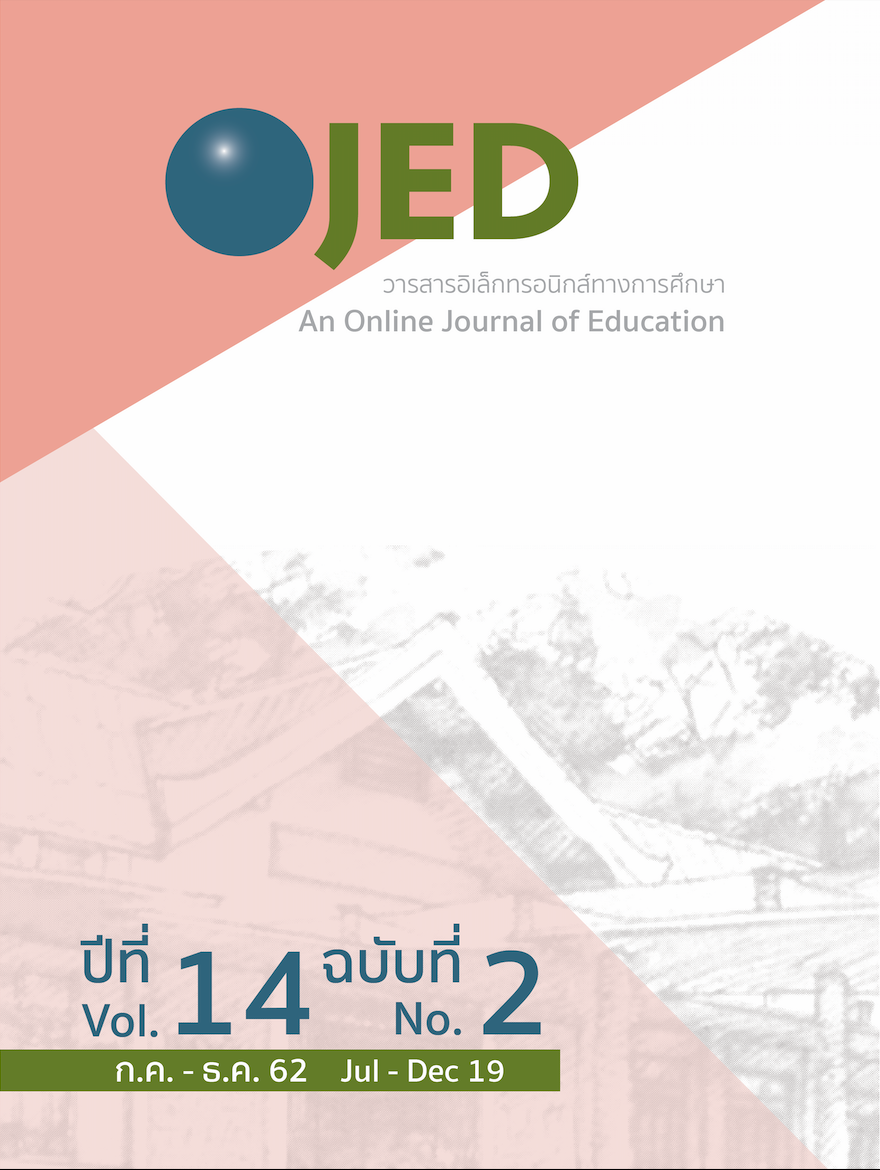A COMPARATIVE STUDY OF COLLABORATIVE WRITING THROUGH SMALL MIXED-ABILITY GROUPS TO REDUCE WRITING ANXIETY OF GRADE 12 STUDENTS
DOI:
https://doi.org/10.14456/ojed.2019.44Keywords:
Writing Anxiety, Collaborative Writing, Mixed-Ability GroupAbstract
This research is quasi-experimental research. The study aimed to 1) investigate the difference of pre and post writing anxiety level of mixed-ability groups before and after experiencing in collaborative writing 2) find the best pattern of small mixed-ability groups to reduce Grade 12 students’ writing anxiety in collaborative writing. The participants of this study were twelve of Grade 12 students. The students enrolled in English Writing, a summer course at one secondary school in the Secondary Educational Service Area Office 1. They were selected using quota sampling. The research instruments were 1.) The Second Language Writing Anxiety Inventory (SLWAI) questionnaire 2) Pre and Post writing tests 3) Three English essays 4) Semi-structured interview questions. The data were analyzed with Means, Dependent Samples T-Test, and Independent Samples T-Test.
The results showed that 1) collaborative writing had a significant effect on the reduction of pre and post writing anxiety level of both mixed-ability groups at the statistical significance of .014* for HMM groups and .005* for HLL groups. 2) There was no mixed-ability group that was the best to reduce writing anxiety because both mixed-ability groups gradually relieved their writing anxiety level almost in the same amount after experiencing in collaborative writing with no statistical difference.
References
Challob, A. I., Bakar, N. A., & Latif, H. (2016). Collaborative Blended Learning Writing Environment: Effects on EFL Students' Writing Apprehension and Writing Performance. English Language Teaching, 9(6), 229-241. doi:10.5539/elt.v9n6p229
Changlek, A., & Palanukulwong, T. (2017). Motivation, anxiety and grit: Interactive factors determining language learning success. Journal of Liberal Arts, Prince of Songkla University, Hat Yai Campus, 9(2), 88-116. Retrieved from https://tci-thaijo.org/index.php/journal-la/article/download/107700/85495/.
Cheng, Ys. (2004). A measure of second language writing anxiety: Scale development and preliminary validation. Journal of Second Language Writing, 13, 313-335. doi:10.1016/j.jslw.2004.07.001
Cheng, Ys. (2004). EFL Students' Writing Anxiety: Sources and Implications. English Teaching & Learning. 29. 41-62. Retrieved from https://www.researchgate.net/publication/306392321_EFL_Students'_Writing_Anxiety_Sources_and_Implications
Chinpakdee, M. (2015). Thai EFL University Students' Perspectives on Foreign Language Anxiety. Silpakorn University Journal of Social Sciences, Humanities and Arts, 15(3). Retrieved from https://tci-thaijo.org/index.php/hasss/article/view/44672.
Debao, A. F., & Blum, A. (2013). Collaborative Writing in Pairs and Small Group. System, 41, 365-378. doi:10.1016/j.system.2013.02.002
Ekmekci, E. (2018). Exploring Turkish EFL Students' Writing Anxiety. The Reading Matrix: An International Online Journal, 18(1), 158-175. Retrieved from https://www.researchgate.net/publication/324825129_Exploring_Turkish_EFL_Students'_Writing_Anxiety.
Flower, L., & Hayes, J. R. (1981). A Cognitive Process Theory of Writing. College Composition and Communication, 32(4), 364-387. Retrieved from www.jstor.org/stable/356600.
Jacobs., Holly. L., Stephen, A., Zingkgraf., Deanne. R., Wormuth, V., Faye, H., Jane, B., Hughey. (1981). Testing ESL Composition: A Practical Approach. Rowley: Newbury House Publishers, Inc.
Krashen, S. (1982). Principles and Practice in Second Language Acquisition. Retrieved from https://www.sdkrashen.com/content/books/principles_and_practice.pdf
Li, M., & Zhu, W. (2017). Good or bad collaborative wiki writing: Exploring links between group interactions and writing products. Journal of Second Language Writing, 35, 38-53. doi:10.1016/j.jslw.2017.01.003
Lin, O. P., & Maarof, N. (2013). Collaborative Writing in Summary Writing: Student Perceptions and Problems. Procedia-Social and Behavioral Sciences, 90, 599-606. doi:10.1016/j.sbspro.2013.07.131
Lowry, P. B., Curtis, A., & Lowry, M. R. (2004). Building a Taxonomy and Nomenclature of Collaborative Writing to Improve Interdisciplinary Research and Practice. Journal of Business Communication, 41(1), 66-99. doi:10.1177/0021943603259363
McDonough, K., De Vleeschauwer, J., & Crawford, W. (2018). Comparing the quality of collaborative writing, collaborative prewriting, and individual texts in a Thai EFL context. System, 109-120. doi:10.1016/j.system.2018.02.010
Ministry of Education. (2008). Basic Core Curriculum B.E.2551 (A.D. 2008). Bangkok: Ministry of Education.
Parichut, W., & Chinokul, S. (2014). English Language Writing Anxiety among Grade 11 Thai Students. OJED, 9(1), 657-671. Retrieved from https://tci-thaijo.org/index.php/OJED/article/view/37265.
Rbuiaee, A. A., Darus, S., & Bakar, N. A. (2015). Collaborative Writing: A Review of Definitions from Past Studies. SOLLs.INTEC 2015 Proceedings, 138-149. doi:10.13140/RG.2.1.3932.7760
Rungruangthum, M. (2011). Writing Anxiety: EFL Postgraduate Students Writing Research Papers in English. Journal of English Studies, 6, 185198. Retrieved from https://tci- thaijo.org/index.php/jsel/issue/view/2524.
Sharpe, M. (2017). L2 composition projects for mixed proficiency writers. ResearchGate. doi:10.13140/RG.2.2.18677.99045
Storch, N. (2005). Collaborative writing: Product, process, and students' reflections. Journal of Second Language Writing, 14, 153-173. doi:10.1016/j.jslw.2005.05.002
Wahyuni, S., & Umam, K. (2017). An Analysis on Writing Anxiety of Indonesian EFL College Learners. JEELS, 4(1), 105-127. doi:10.30762/jeels.v4i1.333
Yu, S., & Hu, G. (2017). Can higher-proficiency L2 learners benefit from working with lower-proficiency partners in peer feedback?. Routledge, 22(2), 178-192. doi:10.1080/13562517.2016.1221806
Zhang, H. (2011). A Study on ESL Writing Anxiety among Chinese English Majors – Causes, Effects and Coping Strategies for ESL Writing Anxiety. (Unpublished Dissertation). Kristianstad University, Sweden.
Downloads
Published
How to Cite
Issue
Section
License
Copyright (c) 2019 An Online Journal of Education

This work is licensed under a Creative Commons Attribution-NonCommercial-NoDerivatives 4.0 International License.




